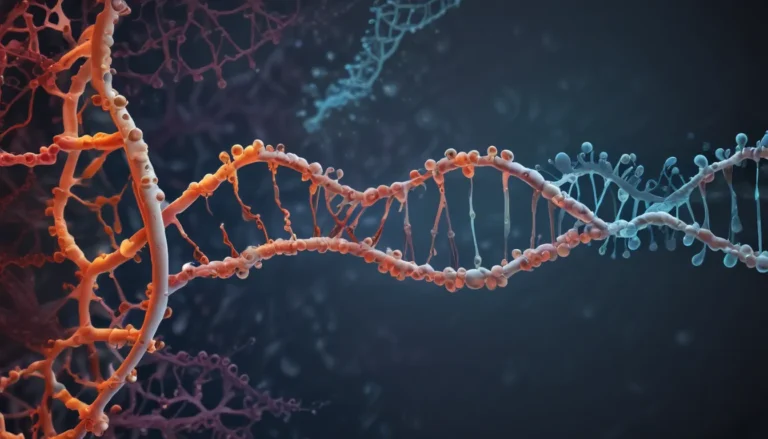A Note About Images: The images used in our articles are for illustration purposes only and may not exactly match the content. They are meant to engage readers, but the text should be relied upon for accurate information.
Plants are the silent heroes of our ecosystem, not only providing beauty to our surroundings but also showcasing a mesmerizing anatomy that allows them to thrive in diverse environments. From the intricate root systems to the specialized leaf structures, plants have evolved unique features that continue to captivate scientists, gardeners, and nature enthusiasts alike. In this article, we will embark on a journey through the enchanting world of plant anatomy, unraveling 13 enigmatic facts that shed light on the inner workings of these remarkable organisms.
Exploring the Marvels of Plant Anatomy
Plants are truly amazing living beings that possess a myriad of adaptations that enable them to flourish in their surroundings. By understanding plant anatomy, we can unravel the mysteries behind how plants harness sunlight for energy, regulate gas exchange, and sustain themselves in various ecosystems. Let’s delve deeper into the captivating world of plant anatomy and uncover the hidden secrets that make these botanical wonders truly extraordinary.
The Marvel of Photosynthesis
One of the most astonishing feats of plants is their ability to transform sunlight into food through a process known as photosynthesis. By harnessing the power of sunlight, plants can produce glucose, their primary source of energy, using just water and carbon dioxide. This magical transformation not only sustains the plant itself but also plays a vital role in supporting life on Earth by producing oxygen as a byproduct.
The Hidden World of Stomata
Stomata, the tiny openings found on the surface of leaves and stems, play a crucial role in the gas exchange process of plants. These microscopic structures allow plants to take in carbon dioxide for photosynthesis while releasing oxygen, contributing to the balance of gases in the atmosphere. Moreover, stomata can regulate water loss by closing up during hot and dry conditions, showcasing the adaptive mechanisms that plants have developed over time.
The Wonder of Trichomes
Trichomes, the hair-like structures that cover the surface of plants, serve various functions that contribute to the plant’s overall well-being. Some trichomes produce toxic substances to deter herbivores, while others reduce water loss by providing insulation. Additionally, the presence of trichomes can give plants a fuzzy appearance, enhancing their aesthetic appeal and adding to their uniqueness in the botanical world.
The Intricacies of Xylem and Phloem
Xylem and phloem are specialized tissues that make up the vascular system of plants, facilitating the transportation of water, nutrients, and sugars throughout the plant. Xylem transports water and essential minerals from the roots to the rest of the plant, while phloem distributes sugars produced during photosynthesis to support growth and development. This intricate network ensures that vital substances are efficiently distributed within the plant, enabling it to thrive.
The Unique Adaptations of Root Systems
Roots serve as the foundation of plants, providing stability and anchorage in the soil while absorbing water and nutrients essential for growth. Different plant species have evolved diverse root systems to adapt to various soil conditions, with some plants developing taproots that penetrate deeply into the ground, while others have fibrous roots that spread out extensively. These adaptations highlight the resilience and versatility of plants in adapting to their environments.
The Complexities of Leaf Structures
Leaves are not merely green structures for capturing sunlight but come in a variety of shapes, sizes, and arrangements, each serving a specific purpose in the plant’s life cycle. Some leaves have needle-like structures that reduce water loss, while others are broad and flat to maximize surface area for photosynthesis. The diversity of leaf structures showcases the incredible adaptability of plants in optimizing their energy production and survival.
The Mystery of Plant Reproduction
Plants exhibit fascinating methods of reproduction, ranging from asexual propagation to intricate flower structures for sexual reproduction. Flowering plants rely on pollinators such as bees and butterflies to transfer pollen from one flower to another, leading to the formation of seeds and fruits. This reproductive strategy not only ensures genetic diversity but also plays a crucial role in the plant’s life cycle and continued propagation.
The Stubbornness of Bark
Bark, the protective outer covering of plants, serves as a shield against physical damage, pathogens, and harsh weather conditions. Some trees, like the cork oak, have the remarkable ability to regenerate bark if damaged or peeled off, ensuring the longevity and survival of these woody plants. This resilience in the face of adversity showcases the remarkable adaptability of plants in protecting themselves and thriving in challenging environments.
The Marvelous World of Plant Cells
Plant cells possess unique structures that allow them to carry out specialized functions essential for the plant’s survival. Chloroplasts, for example, are responsible for photosynthesis, while vacuoles store water and nutrients, enabling the plant to maintain its structural integrity. Some plant cells can undergo cell division throughout their lifespan, contributing to growth and repair processes that sustain the plant’s overall health and development.
The Adaptability of Adventitious Roots
Adventitious roots, which develop from unconventional sources such as stems or leaves, provide additional support and aid in nutrient absorption for plants in challenging environments. The adaptability of plants to develop these extra roots highlights their resilience and survival strategies in adverse conditions. By adjusting to their surroundings, plants can overcome obstacles and continue to thrive in diverse habitats.
The Surprising World of Carnivorous Plants
Some plants have evolved unique strategies to capture and digest insects for additional nutrients, showcasing their remarkable adaptability in challenging environments. Carnivorous plants like the Venus flytrap and pitcher plants have specialized structures that lure and trap unsuspecting prey, providing them with essential nutrients to supplement their diet. This extraordinary feature of plants demonstrates the diversity of survival mechanisms found in the botanical world.
The Intricacies of Lateral Meristems
Lateral meristems play a crucial role in the secondary growth of plants, leading to an increase in girth and the formation of woody tissues. These meristems are responsible for the growth and development of stems and roots, contributing to the structural integrity and overall longevity of plants. Without the presence of lateral meristems, plants would not be able to reach impressive heights and sustain their growth over time.
The Resilience of Plant Life
Plants exhibit incredible resilience in the face of adversity, withstanding extreme temperatures, drought, and recovering from damage to continue their existence. Some plants can regenerate from a small fragment, showcasing their remarkable ability to adapt and survive in challenging conditions. This resilience not only ensures the plant’s survival but also contributes to the overall health and diversity of plant life in various ecosystems.
As we unravel the enigmatic facts about plant anatomy, we gain a deeper appreciation for the complexity and beauty of the botanical world. Plants continue to captivate us with their intricate structures and functions, highlighting their essential role in sustaining life on our planet. By exploring plant anatomy, we not only learn about the wonders of nature but also gain valuable insights into the growth and adaptation of these remarkable organisms.
Conclusion
Plant anatomy unveils a world of wonders that showcase the intricate structures and functions of plants, allowing us to delve into the inner workings of these fascinating organisms. From the miraculous process of photosynthesis to the diverse adaptations of roots and leaves, studying plant anatomy provides us with a deeper understanding of how plants thrive and interact with their environments. The 13 enigmatic facts presented in this article offer a glimpse into the captivating world of plant anatomy, emphasizing the beauty and significance of plants in sustaining life on Earth.
By exploring the diverse cellular composition, reproductive strategies, and specialized tissues found in plants, we can unlock the secrets that contribute to their growth and development. Furthermore, understanding plant anatomy has practical applications in agriculture, horticulture, and medicine, enabling scientists to develop innovative cultivation techniques and discover new medicinal compounds to benefit humanity and the environment.
Whether you’re a botanist, a gardening enthusiast, or simply curious about the natural world, delving into the world of plant anatomy allows us to marvel at the intricate designs and adaptations that plants have developed over millions of years. Their resilience, diversity, and beauty continue to inspire us and remind us of the vital role they play in sustaining life on our planet.
FAQs
-
What is plant anatomy?
Plant anatomy is the study of the internal structures of plants, including cells, tissues, and organs that make up their bodies. -
Why is plant anatomy important?
Understanding plant anatomy is crucial for various fields such as agriculture, horticulture, and medicine. It helps develop better cultivation techniques, discover new medicinal compounds, and gain insights into plant growth and development. -
What are some examples of specialized plant tissues?
Specialized plant tissues include xylem, phloem, and epidermal tissues. Xylem transports water and nutrients from roots to the rest of the plant, while phloem distributes sugars produced during photosynthesis. Epidermal tissues protect the plant’s surface and prevent external damage. -
How do plants reproduce?
Plants reproduce through various methods, including sexual and asexual reproduction. Sexual reproduction involves the fusion of male and female gametes, while asexual reproduction produces offspring without the involvement of gametes. -
What are some unique adaptations of plant root systems?
Plants have evolved various root adaptations to survive in different environments, including taproots for deep anchorage, fibrous roots for efficient nutrient absorption, and prop roots for additional support. -
How do plants transport water?
Plants transport water through specialized cells called xylem, which form channels that carry water and dissolved nutrients from roots to the rest of the plant. -
What is the purpose of leaf veins?
Leaf veins, also known as vascular bundles, transport water and nutrients throughout the leaf, providing support and facilitating photosynthesis and other metabolic processes. -
How do plants adapt to different environmental conditions?
Plants adapt to diverse environments by altering leaf shape, developing specialized root structures, and adjusting their reproductive strategies. These adaptations enable plants to thrive in a variety of habitats. -
What is the role of stomata in plant anatomy?
Stomata are tiny openings on plant leaves and stems that regulate gas exchange, allowing for the intake of carbon dioxide, the release of oxygen, and the regulation of water loss through transpiration. -
How do plants protect themselves?
Plants have developed defense mechanisms such as thorns, toxins, and chemicals to protect themselves from herbivores, pathogens, and environmental stressors.
Exploring the wonders of plant anatomy showcases the marvels of the botanical world, from the intricacies of cellular structures to the remarkable adaptations of plant species. As we uncover these enigmatic facts, we gain a deeper appreciation for the resilience, complexity, and beauty of plants, reminding us of their indispensable role in sustaining life on Earth.






